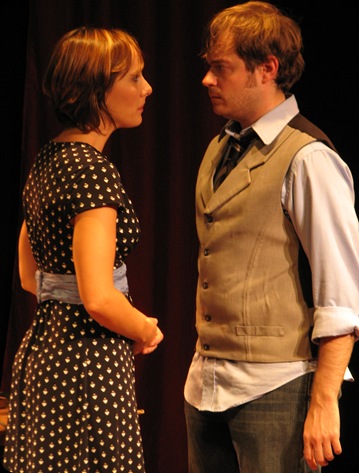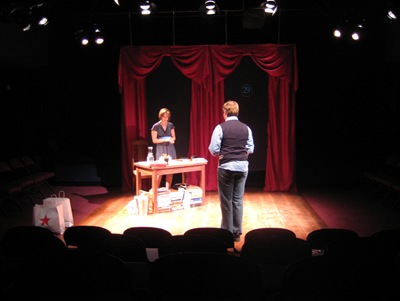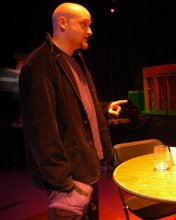Walking the Walk
I have talked a bit about my feelings regarding indie theatre design aesthetics, and you know that I try to hold myself accountable for living up to my own bumperstickers, so with The Nina Variations (good seats still available!) open: let’s go get my report card.
To review in brief:
- Stop complaining about the budget.
- Leverage technology.
- Leverage the two things indie theatre (usually has):
Willing help and time. - Design within your skill limitations.
- Design far enough to look good, and not so far that you can’t make it look finished.
- Design to your mission statement.
If you are a text focused, or actor/director focused troupe… don’t drop your entire budget on the aesthetic.
This was my lab really.
I had no constraints on the design. The only limits were a budget of about $700 and my own paltry carpentry skills.
The goals:
A tight isolated playing space on the floor of the theatre rather than the stage. We wanted to mask the stage off from the audience and play the show in a vary intimate 100 seat 3/4 thrust. I needed a projection surface for the variation numbers and room for a desk.
Everything else was up to me.
I decided immediately that I wanted a wide plank floor.
In looking at image after image online of plank flooring we knew that we wanted vintage pine floors. Unfortunately… so does everyone else, and our budget wouldn’t allow for True Vintage. Instead I decided to stain the flooring, and after consulting with Will (the director) we went with a nice walnut color.
As it turns out, I am an amateur floor stainer. Not really news, but it worked in our favor. The deck look really nice and glossy under street lighting with reddish undertones. Under stage lighting however it blasts out to a farmhouse warm-yellow-brown and shows all of the inconsistencies in my application… which looks great.
For the masking I had decided on curtains because we couldn’t come up with a reasonable projection surface, and we didn’t want walls. I wanted the drape and color of the curtains to mimic traditional theatre curtains in line with my eventual design concept that they were performing this Seagull mashup on the lakeside stage (yes it was late in the process, but I got there).
The desk and chair were both happy accidents as our AD and stage manager had the right pieces. The set is dressed simply with theatre books and a few writing aids (all from my library) to block off the under desk a bit from the audience and as part of my (now apocryphal) idea that they had been doing this for longer than the length of the play. Also, in a bout of no foresight, I didn’t treat the underlayment, and didn’t finish the sides of the planks. Thus the inevitable seams showed brand new raw wood. Not acceptable.
In a funny moment that can only happen after a long day of load-in I asked myself what my wife’s friend Sarah would do. Now Sarah is briiliant, she was one of the designers/creators of Transformations this spring, and she stops at nothing to Get It Right. So playing What Would Sarah Do? is a worthwhile game. My tired brain said that Sarah would mix paint with the sawdust (on stage proper) and essentially grout with it. I was going to do no such thing. I had no paint, not enough sawdust, and would make a huge bloody wreck of the whole thing. “Well. Alright. I just need to cover the raw wood. I don’t need to ‘treat’ it… dirt. I’ll just sweep dirt into the cracks!”
And I did. I took some potting soil in on Tuesdya and spent a half-hour or forty five minutes sweeping dirt into the cracks. It covered (or dirtied) the raw wood, it took the high gloss of my onecoat poly/stain AND it took care of all but the biggest creaks in my floor. (Thanks Sarah!)
Also, in a sidebar.. our space is an older municipal building, and it smells like an older municipal building. So we mist with clove oil… control the experience as much as you can.
Overall, (dirt aside) the results are very clean if still imperfect. My “lighting design” doesn’t really serve the piece, and is too hemmed in by the chosen space layout and the need to be off the back wall. The pipe pockets on the black curtains are uneven, and I haven’t hit on a good (cheap/free) treatment for the top curtain seam or the hanging chains.
But it stays out of the way of the incredibly solid acting (once we take the curtains off the upstage lip) and most importantly: it doesn’t look cheap. There is nothing on the set found, borrowed, purchased or donated that wasn’t chosen. It may not have been the first choice, it may not be the best choice, but it wasn’t because “Well that’s the best we can do, we’re poor”.
That’s the first step.










